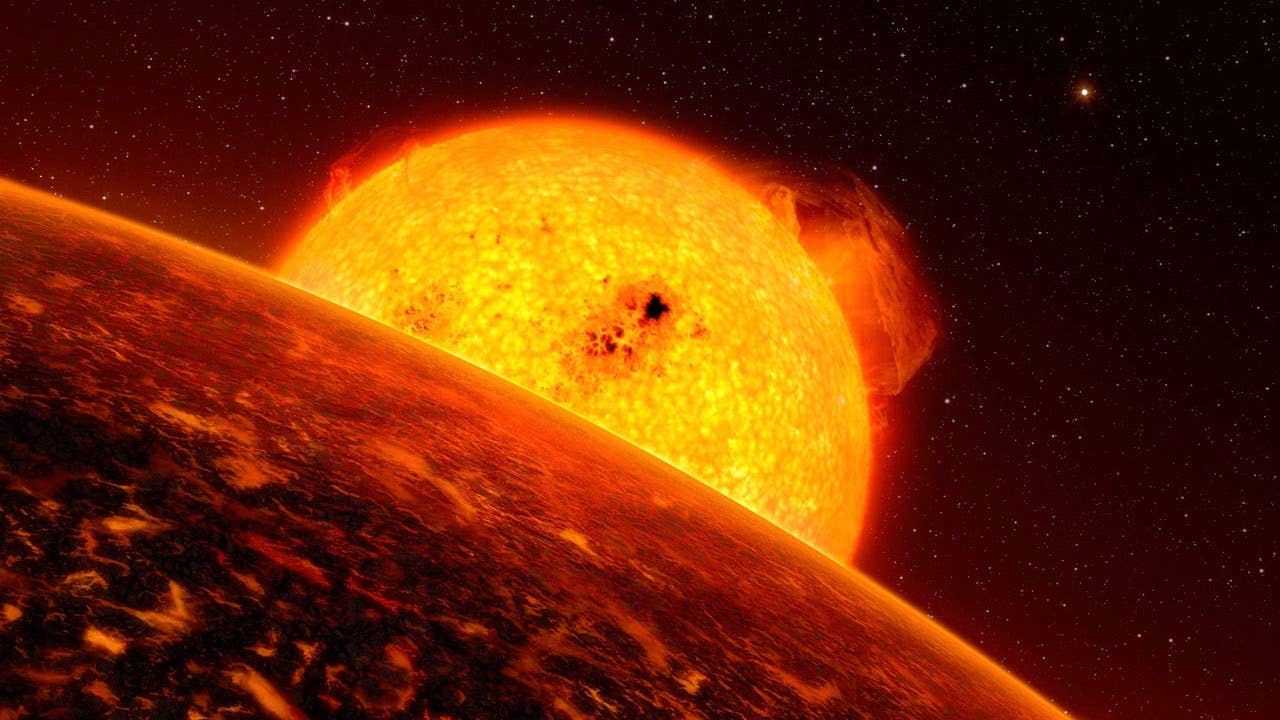The Ghost of Ancient Earth’s Magma Oceans Found in Greenland Rocks

Share
Our planet’s history is written in its rocks. You can traverse eons by brushing your fingers over the layers of a cliff wall. But beyond a certain point, the record goes blank. Though the Earth is roughly 4.5 billion years old, the oldest-known rocks date back to only around 4 billion years ago. The relentless motions of Earth’s tectonic plates have recycled its surface.
Still, chemical clues can take us further back in time to when young Earth was a lava planet. Scientists believe a series of mammoth impacts—the last of which formed the moon—liquified the surface and formed planet-wide magma oceans hundreds of miles deep. The rocks from this fiery era are long gone, but their ghost lives on.
In a new study, published in Science Advances, University of Cambridge scientists say they’ve found evidence of ancient Earth's magma oceans in 3.7-billion-year-old rocks in Greenland.
As the magma oceans gradually cooled and crystallized into rock, the planet we know—its internal structure, surface, and atmosphere—began to take form. Understanding this phase can help explain how Earth evolved from a hell-planet to the cradle of life.
But it's no easy task.
"There are few opportunities to get geological constraints on the events in the first billion years of Earth's history. It's astonishing that we can even hold these rocks in our hands—let alone get so much detail about the early history of our planet," said lead author Dr. Helen Williams, from Cambridge's Department of Earth Sciences.
Hell and Back
As the Earth cooled and crystalized, scientists believe dense chunks of newly solidified crystals sank deep into the Earth's lower mantle, near the core of the planet. It's thought they may even exist today in "ancient crystal graveyards" forever beyond our reach.
But what if remnants, through the ages, rose up through the mantle and re-emerged on the surface by way of volcanic eruptions? The trip through the mantle would no doubt thoroughly transform them, but in theory, chemical traces of their origins would remain.
It was this theory the Cambridge team went looking to prove.
"The driving question that motivated me was, if we think the magma ocean stage was important to the Earth’s history, why is there no geological evidence for it?" Williams told Gizmodo. "What if we actually tried to directly hunt for it?"
The rocks hail from Greenland's Isua supercrustal belt. The basalt there—a kind of volcanic rock—is famous for being the oldest on Earth, yielding up evidence for the earliest life on our planet, early plate tectonics, and now, it appears, an even more ancient era.
"It was a combination of some new chemical analyses we did and the previously published data that flagged to us that the Isua rocks might contain traces of ancient material," said co-author Dr. Hanika Rizo of Carleton University.
Using forensic chemical analysis and thermodynamic modeling, the team traced the Greenland rocks' origins and their path to the surface.
Be Part of the Future
Sign up to receive top stories about groundbreaking technologies and visionary thinkers from SingularityHub.


When rock heats up in the planet's interior it begins to rise through the mantle, eventually emerging in volcanic events. Isotopes in the rock can act as a record of its journey, a bit like stamps in a passport. In this case, the scientists found the stamp of unique iron isotopes likely formed in an extremely high-pressure homeland some 430 miles below the surface—a region scientists also expect houses those magma ocean "crystal graveyards."
"Those samples with the iron fingerprint also have a tungsten anomaly—a signature of Earth's formation—which makes us think that their origin can be traced back to these primeval crystals," Williams said.
Further study of their chemistry revealed a tortuous journey that included several phases of cooling, crystalizing, heating, and remelting.
Yet, despite their transformation by events in the interior, Williams wrote in a Conversation article on the study that "the rocks that emerged, located in present-day Greenland, still retain chemical signatures that connect them to Earth's magma-covered past."
A Story Still Being Read
While discovering a new geosignature of Earth's ancient past is an exciting step, there's plenty more work to do. How long did magma oceans last on the planet, for example, and how much of the planet did they cover? Now that we know what to look for, Williams says we might search other volcanic hotspots in Hawaii or Iceland.
It's a painstaking investigation, but bit by bit, the Earth's early history is being laid bare. Its long-held secrets may help us explain how the planet we know today, one so well suited for living things, formed out of the cauldron of the early solar system.
The more we know about our own planet's history, the more we'll understand how it and other planets form and, by extension, how life began here—and, perhaps, elsewhere too.
Image Credit: Artist's impression of exoplanet CoRoT-7b / ESO/L. Calçada
Jason is editorial director at SingularityHub. He researched and wrote about finance and economics before moving on to science and technology. He's curious about pretty much everything, but especially loves learning about and sharing big ideas and advances in artificial intelligence, computing, robotics, biotech, neuroscience, and space.
Related Articles

Data Centers in Space: Will 2027 Really Be the Year AI Goes to Orbit?

Scientists Say We Need a Circular Space Economy to Avoid Trashing Orbit

New Images Reveal the Milky Way’s Stunning Galactic Plane in More Detail Than Ever Before
What we’re reading
